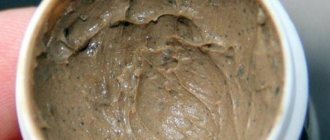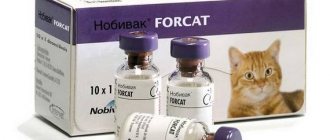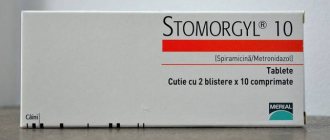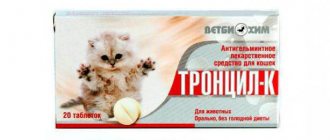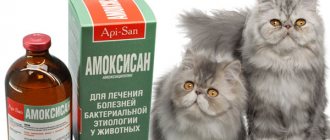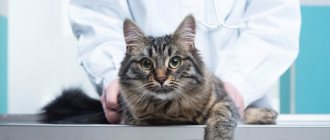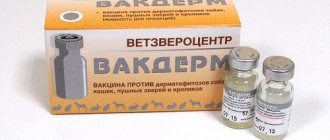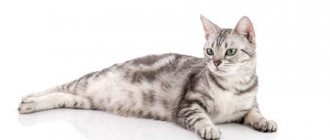general characteristics
Gastric ulceration in humans is a serious condition and there has long been a need to develop effective and convenient ways to eliminate it. Until relatively recently, we relied on simply neutralizing stomach acid by pouring alkaline solutions (ie Alka Seltzer, Tums, Rolaids, etc.) into the stomach. It was a temporary and often incomplete solution to an ongoing stomach acid problem. In fact, gastric ulceration is a complex process, and over time, more sophisticated treatments have become available.
What to do if your pet has gastritis - video
Acyloc helps relieve a cat from vomiting, pain and other signs that accompany digestive disorders, inflammatory processes occurring in the stomach, as well as diseases of other gastrointestinal organs. The drug in the doses prescribed by the doctor allows you to speed up the healing process and return your pet to a normal lifestyle.
Diseases of the gastrointestinal tract are typical not only for humans, but also for cats. Some animals have pathologies from birth, some become ill due to poor nutrition or other reasons. Acylok for cats allows you to effectively combat gastrointestinal problems; this medicine has earned the recognition of many veterinarians.
Dosing of acyloc for cats in ampoules
- 1 kg - 0.1 ml of the drug intravenously in saline or intramuscularly
- 2 kg - dose 0.2 ml of the drug
- cat weight 3 kg - 0.3 ml acyloc 2 times a day
- 4 kg - 0.4 ml of the drug "Acylok"
- 5 kg - 0.5 ml of acyloc 2 times a day i.v. slowly or i.m.
- cat body weight 6 kg - 0.6 ml of medicine
Controlling stomach acid remains an important part of treating and preventing stomach ulcers. Acid secretion by gastric parietal cells is stimulated by three main factors:
- gastrin (a hormone released when food is digested in the stomach)
- acetylcholine (neurotransmitter)
- histamine (the same histamine that is involved in allergies)
There are two types of histamine receptors in the body:
- H1 receptors which lead to hay fever symptoms
- H2 receptors, which are located in the stomach and trigger the secretion of stomach acid.
According to the instructions, acyloc
is a specific antihistamine, similar to its cousins Cimetidine (Tagamet HB®) and Famotidine (Pepcid AC®). These medications are useless in combating allergic symptoms where histamine causes unpleasant effects associated with the so-called H1 receptors; instead, they bind to histamine receptors in the stomach called H2 receptors and control the secretion of stomach acid.
Cimetidine was the first such H2 blocker available and each generation has brought improvements in terms of fewer drug interactions and stronger effects. According to the instructions for use, acyloc offers the added benefit of not only acting as an effective antacid, but also promoting normal stomach contractions. When it comes to treating nausea, normal stomach contractions are critical in preventing food from accumulating in the stomach. Distension of the stomach is a stimulus for vomiting. Acyloc helps with nausea by eliminating both stomach acid and stomach contractions. As an antacid, acyloc is 3-13 times stronger than its predecessor cimetidine.
Conditions for storage and release from pharmacies
The shelf life of the drug is 3 years from the date of release. The medicine must be stored in a place where there is no direct sunlight, at a constant temperature of less than 25 ° C. The product released in the form of a solution should not be allowed to freeze.
The drug is dispensed from pharmacies according to a prescription. The average cost of an injection solution of 25 mg/ml 2 ml (10 ampoules) is 200 rubles.* Tablets are a little more expensive, the average price is 230 rubles. per package.
All injections for cats are painful, so it is better to give the injection together: one holds the pet tightly, the other injects the product
How is acyloc used to treat cats?
Acylok is useful for cats in any situation
when gastric irritation is a problem and ulceration is a pathology. It is often used to treat infections caused by Helicobacter, inflammatory bowel disease, panleukopenia, renal failure, poisoning that may be ulcerative (eg, overdose of aspirin), any disease associated with prolonged vomiting or chronic combination with drugs that may have irritants. stomach properties.
In feline diseases associated with frequent vomiting or regurgitation, the esophagus (the tube connecting the mouth and stomach) can become ulcerated and damaged by prolonged exposure to vomiting/stomach acid. Antacids are also useful in this situation to reduce damage to the esophagus.
Acylok is usually used twice a day and can be used for a long time.
When is the medicine prescribed?
The medicine is used to eliminate inflammatory diseases of the stomach in cats. The drug is indicated for gastritis, ulcerative and erosive lesions of the gastrointestinal tract. The solution helps normalize digestion and eliminates pain in the pet’s stomach. The medication can also be used in the complex treatment of pancreatic diseases in animals. This drug can be prescribed to pets during the postoperative period to prevent the risk of gastric bleeding.
Gastritis in cats is treated with Acylok
H2 blockers stimulate the production of mucus, thereby accelerating the regeneration of inflamed tissues. In addition, this line of products has a beneficial effect on the motor function of the gastrointestinal tract, promoting the movement of food through all departments.
Side Effects/Warnings
Side effects in cats with the use of acyloc are very rare if the drug is used in normal doses. Possible side effects (described in humans) include confusion and headache. In rare cases, agranulocytosis may develop; with rapid intravenous administration, temporary arrhythmia is possible.
After intramuscular injection, there may be pain in the injection area.
Overdose: Clinical experience with overdoses of Acyloc is limited. In laboratory animals, very high doses of the drug (225 mg/kg per day) caused muscle tremors, vomiting and increased respiratory movements. A single administration of the drug to rodents at a dose of 1 g/kg did not lead to death.
Treatment of Acyloc overdose should be carried out using the usual methods used for oral administration of drugs; If necessary, symptomatic and supportive treatment is prescribed. Hemodialysis and peritoneal dialysis are good at removing acyl from the body.
Drug Interactions Unlike cimetidine, acyloc in cats has minimal effect on hepatic drug metabolism and is therefore unlikely to cause clinically significant drug interactions through this metabolic pathway.
Propantheline slows absorption and increases the maximum concentration of acyloc in the blood serum. When these drugs are administered simultaneously, the relative bioavailability of acyloc can increase by 23%. Since antacids can reduce the absorption of acyloc, when used simultaneously, an interval of 2 hours should be made between drugs.
Acyloc may reduce the renal clearance of procainamide
(procainamide), but the clinical significance of these possible interactions is currently unclear.
The manufacturer states that acyloc may affect the bioavailability of some drugs through pH-dependent effects, changes in their volume of distribution, or unknown actions. Research is being conducted on these issues. Interference with laboratory parameters by acyloc may cause false positive results when testing urine protein using Multistix®. In this case, when treating with acyloc, it is recommended to use the sulfosalicylic acid reagent.
Medicines similar in mechanism of action - table
| Name | Release form | Active ingredient | When is the drug prescribed? | Contraindications | Side symptoms | Can it be used to treat pregnant and lactating cats? | Price |
| Ranitidine | pills | ranitidine |
|
|
| No. | From 31 rub. |
| Famotidine |
| famotidine |
|
|
| No. | From 120 rub. |
| Cimetidine | pills | cimetidine |
| intolerance to the active component |
| No. | From 75 rub. |
Medicines with similar effects - photo gallery
Problems and warnings regarding the use of acyloc in cats
- The dose of Acyloc should be reduced in cats with liver or kidney disease
, as these diseases tend to prolong drug activity. - Acyloc appears to be safe for use during pregnancy in cats, but should probably be avoided during nursing.
- Use of Acyloc in cats may result in falsely positive urine protein levels being tested.
- It is our policy not to provide dosing information over the Internet.
Price
The cost of a medicine is determined based on a number of external factors, which include the pharmacy’s markup, the costs incurred by the company for transporting the goods, as well as the purchase price.
Important! You should find out the exact cost of the medicine at your nearest pharmacy.
Russia
The price for Atsilok was set at 270 rubles.
Ukraine
For the same drug you will have to pay on average 156.34 hryvnia.
Video on the topic: Nutrition for gastritis, Tibet Clinic
Learn about essential drugs in animals
- Vaccination of puppies, scheme
- Rabies vaccination schedule for cats
- Vaccination of small pets
- How to vaccinate a kitten?
- Why vaccinate dogs against rabies?
- What vaccinations for kittens?
- Nobivac triquet trio for cats
- Nobivak dhppi
- What is the first vaccination for a puppy?
- Vaccinate your cat
- Tick vaccination for dogs. When to do it?
- What vaccinations are given to dogs and why?
- Ursofalk - dose for a cat
- Serenia for animals
- Ursofalk suspension for dogs, dosage
- Marfloxin for veterinary medicine
- How to use serenia in dogs
- Graying in cats
- Heptor for dogs: dosage
- Lidocaine for dogs
- Heptor in cats
- Lidocaine for cats
- Heptral in dogs
- Can cats use marfloxin?
- Marfloxin for cats - instructions
- Heptral in cats (instructions for use, pharmacology
- Dirofen suspension for cats: instructions
- Vetom 1 for cats
- Instructions: multifel for cats
- Use of fosprenil in cats
^Top
In what dosages and how to give the tablets
Tablets should be given once a day. There should be 1–3 mg per 1 kg of pet’s body weight. The exact amount of the drug is determined by the veterinarian. The course of treatment in most cases does not exceed one week. It is best to give tablets before bed, 1-2 hours after feeding. In this case, the required amount of medicine should be crushed and mixed with water, then draw the liquid into a syringe without a needle and pour it into the animal’s mouth.
In order to give the dissolved tablet to your pet, you can use a syringe without a needle.
If the cat is obedient and calm, then the tablet can be placed on the root of the tongue. Then it is recommended to stroke the pet on the neck, which will provoke a swallowing reflex. It is important to make sure that the medicine gets into the stomach, because cats often manage to spit it out. You can give the pill using a special pill syringe, which is sold at any veterinary pharmacy.
To give your cat medicine, you can use a special syringe for pills.
The active ingredient of the drug belongs to the second generation H2-blockers, therefore it is currently used less and less, since there are more effective drugs (4–5 generations).
A friend's cat got sick. The pet's condition was extremely serious, so everyone thought that he had some kind of serious infection. After a series of tests, the doctor diagnosed pancreatitis. But judging by the results, there was also something wrong with the stomach. An ulcer was suspected. A number of medications were prescribed, including an H2 blocker. A few days later, the cat began to recover, which everyone was very happy about, since before that he couldn’t even get up. In addition, the temperature returned to normal. Complex treatment helped save the animal.
special instructions
If a cat is diagnosed with liver or kidney disease, the daily dose of the drug should be reduced to 50 ml of solution and 150 mg in tablets.
With long-term treatment of elderly and weakened animals, there is a risk of developing a bacterial infection of the digestive system.
During therapy, the diet should not include foods that cause fermentation in the intestines. The best feeding option is a diet food low in fat, gluten and lactose.
At the beginning of treatment, a diagnostic examination should be performed to help exclude the presence of malignant tumors of the stomach, esophagus and duodenum.
The best results are obtained from preventive courses rather than constant use of the product.
